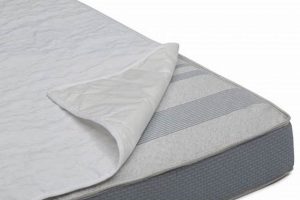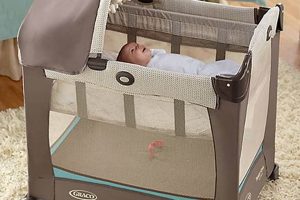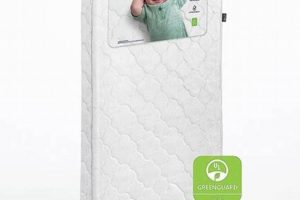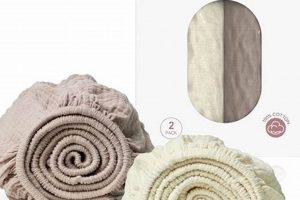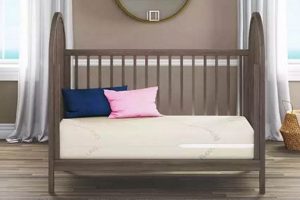A sleep surface designed for Stokke brand cribs, often featuring specific dimensions and construction to ensure a safe and proper fit within the crib frame. These items are typically manufactured with materials like hypoallergenic foam or natural fibers, aiming to provide support and comfort for infants. As an example, a particular model might be constructed with multiple layers of breathable mesh and a washable cover for hygiene.
The selection of an appropriate sleep surface for a crib is critical for infant safety and development. A firm, well-fitting surface reduces the risk of suffocation and promotes healthy spinal alignment. Historically, such products have evolved from simple padded surfaces to incorporating advanced materials and design features focused on breathability, hygiene, and ergonomic support. The importance lies in its direct impact on the infant’s well-being during prolonged periods of rest.
The following sections will delve into aspects such as material composition, safety standards, size and fit considerations, and care instructions relevant to selecting and maintaining appropriate infant sleep surfaces designed for specialized crib systems.
Essential Considerations
The following recommendations are provided to ensure the safe and effective use of a Stokke crib mattress, promoting optimal infant comfort and well-being.
Tip 1: Verify Dimensions: Prior to purchase, meticulously confirm the dimensions of the mattress align precisely with the interior measurements of the Stokke crib model. An improperly sized sleep surface can create gaps, posing a potential safety hazard.
Tip 2: Assess Firmness: The sleep surface should exhibit sufficient firmness to support the infant’s body weight and prevent sinking, which could impede breathing. A simple test involves pressing down on the surface; minimal indentation is desirable.
Tip 3: Examine Material Composition: Investigate the materials used in construction, prioritizing hypoallergenic and breathable options. Certifications such as Oeko-Tex Standard 100 indicate the absence of harmful substances.
Tip 4: Evaluate Cover Features: Opt for a mattress cover that is removable and washable, enabling regular cleaning to maintain a hygienic sleep environment. Waterproof or water-resistant properties are also beneficial for preventing liquid absorption.
Tip 5: Confirm Safety Standards: Verify compliance with relevant safety regulations and certifications, such as those established by ASTM International or other recognized bodies. These standards ensure the product has undergone rigorous testing for safety and performance.
Tip 6: Monitor for Wear and Tear: Regularly inspect the mattress for signs of damage, such as tears, indentations, or compromised seams. Any indication of deterioration warrants immediate replacement.
Tip 7: Adhere to Cleaning Instructions: Strictly follow the manufacturer’s cleaning guidelines to preserve the integrity and lifespan of the mattress. Incorrect cleaning methods can damage materials and compromise its performance.
Adherence to these considerations helps to create a secure and comfortable sleep environment for the infant, contributing to healthy development and minimizing potential risks.
The subsequent discussion will address specific scenarios and troubleshooting techniques related to Stokke cribs and associated accessories.
1. Precise Dimensions
Precise dimensions are a non-negotiable requirement for selecting a Stokke crib mattress. The integrity of the crib’s safety features hinges on the mattress fitting exactly within the designated space, leaving no room for compromise.
- Entrapment Prevention
The primary function of precise dimensions is to eliminate gaps between the mattress and the crib frame. Gaps, even seemingly minor ones, present a significant entrapment hazard for infants, potentially leading to suffocation or injury. A mattress that is even slightly too small can create these dangerous spaces.
- Structural Stability
When a mattress fits snugly within the crib, it contributes to the overall structural stability of the unit. A mattress that is too small or too large can shift during use, potentially destabilizing the crib’s construction and increasing the risk of collapse or damage.
- Uniform Support
A properly sized mattress ensures uniform support across its entire surface. If the mattress is too small, it may sag in the middle, compromising proper spinal alignment and potentially causing discomfort or developmental issues for the infant. Overhang may cause the mattress to become uneven over time due to the difference in support.
- Compatibility with Fitted Sheets
Precision in dimensions facilitates the correct use of fitted sheets designed for Stokke crib mattresses. A poorly fitting mattress will cause fitted sheets to bunch, pull, or be too tight, creating an unsafe sleep environment, and the potential risk of suffocation. The sheets are not supposed to be used as replacement when a mattress don’t have precise dimensions
The implications of neglecting precise dimensions extend beyond mere inconvenience; they directly impact infant safety and well-being. Consistent adherence to manufacturer specifications is critical for mitigating potential risks associated with an improperly fitted Stokke crib mattress.
2. Firmness Level
The firmness level of a Stokke crib mattress is a critical safety and comfort factor. An appropriately firm surface is essential for promoting healthy infant development and minimizing potential risks associated with sleep. The following details outline key facets related to firmness and its impact.
- Sudden Infant Death Syndrome (SIDS) Prevention
A firm mattress reduces the risk of SIDS by preventing the infant from sinking into the surface, which could obstruct breathing. Medical professionals consistently recommend firm mattresses for infants to minimize this risk. A Stokke crib mattress should adhere to these guidelines, offering a stable, unyielding surface.
- Spinal Development Support
Adequate firmness provides the necessary support for proper spinal alignment during sleep. A soft mattress can cause the spine to curve unnaturally, potentially leading to discomfort or developmental issues. The design of a Stokke crib mattress must prioritize ergonomic support, maintaining the infant’s spine in a neutral position.
- Infant Mobility and Motor Skills
A firm surface facilitates infant mobility, enabling them to roll over and move freely within the crib. A mattress that is too soft can restrict movement and hinder the development of motor skills. The Stokke crib mattress should provide a stable platform for the infant to explore and develop these skills.
- Material Density and Durability
Firmness is directly related to the density of the materials used in the mattress’s construction. Higher-density materials provide greater support and resistance to indentation, ensuring the mattress maintains its firmness over time. A durable Stokke crib mattress will retain its structural integrity and continue to provide a safe and supportive sleep environment throughout its use.
The interplay between these facets underscores the significance of firmness in the selection of a Stokke crib mattress. Each element contributes to the overall safety and well-being of the infant, highlighting the importance of adhering to recommended firmness standards and regularly assessing the mattress for signs of wear or softening.
3. Material Safety
Material safety is a paramount concern in the context of a Stokke crib mattress. The materials used in its construction directly impact the health and well-being of the infant, necessitating a comprehensive understanding of potential hazards and safety standards.
- Chemical Emissions
The emission of volatile organic compounds (VOCs) from mattress materials is a significant consideration. VOCs, released from synthetic foams and adhesives, can contribute to indoor air pollution and potentially trigger respiratory issues or allergic reactions in infants. A safe Stokke crib mattress will utilize materials with low or zero VOC emissions, often certified by independent organizations like CertiPUR-US or OEKO-TEX Standard 100. These certifications verify that the materials have been tested and found to be below specified thresholds for harmful chemicals.
- Flame Retardants
Traditional flame retardants, such as polybrominated diphenyl ethers (PBDEs), have raised health concerns due to their persistence in the environment and potential neurodevelopmental effects. Regulations have restricted or banned the use of certain PBDEs in consumer products, including mattresses. A material-safe Stokke crib mattress will either avoid the use of chemical flame retardants altogether, opting for inherently flame-resistant materials like wool, or employ alternative, less toxic flame retardant chemicals that meet current safety standards.
- Allergenic Substances
The presence of allergenic substances, such as latex or certain dyes, can trigger allergic reactions in sensitive infants. Manufacturers of Stokke crib mattresses should disclose the materials used and avoid those known to be common allergens. Natural materials, while often perceived as safer, can also be allergenic; thorough processing and washing are essential to minimize potential risks. Certifications guaranteeing the absence of specific allergens may also be relevant.
- Heavy Metals
Heavy metals, such as lead, mercury, and cadmium, can be present in certain dyes, pigments, and other mattress components. These substances are toxic and can pose serious health risks to infants, even at low levels of exposure. A material-safe Stokke crib mattress will be manufactured using materials that are free from heavy metals, adhering to relevant regulations and guidelines that limit their presence in consumer products.
The aforementioned facets of material safety underscore the critical need for meticulous evaluation of the components used in Stokke crib mattresses. Selecting a product that prioritizes non-toxic, low-emission, and allergen-free materials is paramount for safeguarding infant health and creating a secure sleep environment. The integration of certified materials and transparent manufacturing processes serves as an assurance of product safety and quality.
4. Breathability
Breathability, in the context of a Stokke crib mattress, refers to the ability of the mattress materials to allow air to circulate freely. This circulation minimizes heat and moisture buildup, mitigating the risk of infant overheating and fostering a more comfortable sleep environment. Material selection and mattress construction are directly linked to breathability. For instance, mattresses incorporating open-cell foam structures or natural fibers such as wool or cotton typically exhibit superior breathability compared to those made with closed-cell foam or synthetic materials. Reduced breathability can lead to increased sweating, discomfort, and potential skin irritation, disrupting the infant’s sleep patterns.
The design of the mattress cover also significantly impacts breathability. Covers made from tightly woven synthetic fabrics can impede airflow, negating the benefits of breathable core materials. Conversely, covers made from breathable materials like organic cotton or bamboo can enhance airflow, further promoting a comfortable and safe sleep environment. A practical example is a mattress featuring a 3D mesh cover, which creates an air gap between the infant and the mattress surface, facilitating optimal ventilation. In situations where infants are prone to spitting up or sweating, a highly breathable mattress can help prevent moisture from being trapped against the skin, reducing the likelihood of skin rashes.
In summary, breathability is a crucial component of a Stokke crib mattress, directly influencing infant comfort and safety. Selection of materials and construction techniques that maximize airflow is essential. The challenge lies in balancing breathability with other important factors, such as firmness and support, to create an optimal sleep surface. Understanding the impact of material choices on breathability allows for informed decision-making, contributing to a healthier and more restful sleep experience for the infant.
5. Hygiene
Maintaining a high standard of hygiene for a Stokke crib mattress is crucial for safeguarding infant health. A clean sleep environment minimizes exposure to bacteria, allergens, and other contaminants that can compromise well-being. The materials and construction of the mattress significantly influence its ability to maintain hygiene.
- Removable and Washable Covers
The presence of a removable and washable cover is a primary determinant of mattress hygiene. These covers allow for regular cleaning, removing spills, drool, and other substances that can harbor bacteria. Frequent washing, following the manufacturer’s instructions, helps prevent the buildup of allergens and maintains a sanitary sleep surface. The absence of a removable, washable cover makes it significantly more difficult to maintain hygiene.
- Water Resistance and Stain Resistance
Water-resistant or stain-resistant properties help protect the mattress core from moisture penetration. Moisture creates an environment conducive to bacterial and fungal growth. While not a substitute for regular cleaning, these features offer an additional layer of protection against contamination. A mattress lacking these properties requires more frequent and thorough cleaning to prevent unsanitary conditions.
- Material Composition and Antimicrobial Properties
Certain materials exhibit inherent antimicrobial properties or are treated to inhibit the growth of bacteria and fungi. For example, some mattress covers incorporate silver ions, which are known for their antimicrobial effects. The use of such materials contributes to a more hygienic sleep environment, reducing the risk of microbial contamination. Consideration should be given to the safety of any added antimicrobial agents, ensuring they are non-toxic and hypoallergenic.
- Ventilation and Airflow
Adequate ventilation and airflow within the mattress structure help dissipate moisture and prevent the growth of mold and mildew. Mattresses with breathable materials and designs promote air circulation, creating a less hospitable environment for microorganisms. A mattress with poor ventilation is more likely to retain moisture, increasing the risk of microbial growth and unpleasant odors.
These facets of hygiene are integral to the overall suitability of a Stokke crib mattress. A combination of removable covers, water resistance, antimicrobial materials, and adequate ventilation contributes to a cleaner, healthier sleep environment for the infant, minimizing exposure to potential contaminants and promoting well-being.
6. Support
The term “support,” when discussing a Stokke crib mattress, extends beyond simple comfort. It encompasses the mattress’s ability to provide correct spinal alignment, pressure distribution, and overall stability for the developing infant. Proper support is crucial for healthy growth and minimizing the risk of physical discomfort.
- Spinal Alignment
A primary function of mattress support is to maintain the infant’s spine in a neutral position. Excessive sinking or uneven surfaces can lead to spinal misalignment, potentially causing discomfort and long-term developmental issues. A well-designed Stokke crib mattress will offer firm, even support to promote proper spinal alignment during sleep. An example is a multi-layered foam construction, where each layer is engineered to provide specific levels of support and pressure relief.
- Pressure Distribution
Even pressure distribution is essential to prevent localized pressure points that can cause discomfort or restrict circulation. A supportive mattress will distribute the infant’s weight evenly across its surface, minimizing pressure on sensitive areas like the head, shoulders, and hips. Some Stokke crib mattresses utilize zoned support systems, where different areas of the mattress are engineered to provide varying levels of support based on the infant’s anatomy. For example, a softer zone might be incorporated under the shoulders to accommodate side sleeping, while a firmer zone supports the hips for back sleeping.
- Edge Support
Adequate edge support enhances the usable sleep surface and prevents the infant from rolling off the mattress. Strong edge support also contributes to the overall structural integrity of the mattress, preventing sagging and maintaining a consistent level of support over time. A well-designed Stokke crib mattress will feature reinforced edges to provide stable support along the perimeter. This edge support is particularly important as the infant begins to move more freely within the crib.
- Firmness and Stability
The overall firmness and stability of the mattress directly contribute to its ability to provide consistent support. A mattress that is too soft can compromise spinal alignment and create a feeling of instability, while a mattress that is too firm can be uncomfortable and restrict movement. Stokke crib mattresses aim to strike a balance between firmness and comfort, offering a stable and supportive sleep surface that conforms to the infant’s body without excessive sinking. A stable mattress also reduces the risk of the infant becoming trapped in soft spots.
These facets of support, when effectively integrated into the design and construction of a Stokke crib mattress, contribute significantly to the infant’s comfort, safety, and healthy development. The appropriate balance of spinal alignment, pressure distribution, edge support, and firmness is essential for creating an optimal sleep environment. Failure to address these facets can result in discomfort, developmental problems, and increased safety risks.
7. Durability
Durability, in the context of a Stokke crib mattress, signifies the product’s ability to withstand prolonged use and maintain its structural integrity, safety features, and intended performance characteristics over an extended period. It is a critical factor influencing the mattress’s overall value and its contribution to a safe and comfortable sleep environment for the infant.
- Material Resilience
The inherent resilience of the materials used in the mattress construction is paramount. High-density foams, tightly woven fabrics, and robust stitching contribute to a mattress that resists sagging, tearing, and degradation over time. For instance, a mattress utilizing high-density polyurethane foam is likely to retain its shape and firmness longer than one using lower-density materials. Similarly, a cover made from durable, stain-resistant fabric will withstand repeated cleaning and resist wear and tear, maintaining its protective function. A failure in material resilience leads to compromised support and potential safety hazards.
- Construction Integrity
The method of construction, including seams, bonding, and internal support structures, directly affects the mattress’s durability. Well-reinforced seams prevent separation and tearing, while robust bonding ensures that different layers of the mattress remain securely adhered. Internal support structures, such as strategically placed coils or support beams, distribute weight evenly and prevent sagging. As an example, a mattress with double-stitched seams and reinforced corners will be more resistant to damage than one with single-stitched seams and minimal reinforcement. Compromised construction integrity can result in uneven support and reduced lifespan.
- Resistance to Environmental Factors
A durable Stokke crib mattress exhibits resistance to environmental factors such as moisture, temperature fluctuations, and UV exposure. Moisture can lead to the growth of mold and mildew, compromising hygiene and accelerating material degradation. Temperature fluctuations can cause materials to expand and contract, potentially leading to cracking or warping. UV exposure can fade colors and weaken fabrics. A mattress designed to withstand these factors will utilize moisture-resistant materials, UV-resistant dyes, and construction techniques that minimize the impact of temperature changes. The absence of resistance to environmental factors can significantly shorten the mattress’s lifespan.
- Long-Term Performance Retention
Durability ultimately translates to the mattress’s ability to maintain its intended performance characteristics over time. This includes retaining its firmness, support, breathability, and hygienic properties. A durable Stokke crib mattress will continue to provide a safe and comfortable sleep environment for the infant throughout its intended lifespan. This is often reflected in extended warranties or certifications that guarantee a certain level of performance over a specified period. Lack of long-term performance retention necessitates premature replacement and increased expense.
These facets of durability are intrinsically linked to the overall value proposition of a Stokke crib mattress. A mattress that demonstrates superior material resilience, construction integrity, resistance to environmental factors, and long-term performance retention represents a sound investment, providing both peace of mind and a safe, comfortable sleep environment for the infant. Neglecting durability can lead to premature wear, compromised safety, and increased long-term costs.
Frequently Asked Questions
The following questions address common concerns and provide essential information regarding Stokke crib mattresses, focusing on factors relevant to infant safety and product performance.
Question 1: Are all Stokke crib mattresses the same size?
No. Stokke crib mattresses are designed to correspond with specific Stokke crib models. It is imperative to verify the dimensions of the mattress align precisely with the interior measurements of the intended crib model to avoid potential safety hazards.
Question 2: What level of firmness is appropriate for a Stokke crib mattress?
A firm mattress is recommended for infant safety. The surface should provide adequate support and prevent the infant from sinking, which could impede breathing. The mattress should exhibit minimal indentation when pressed.
Question 3: What materials are commonly used in Stokke crib mattresses?
Materials may include hypoallergenic foam, natural fibers like cotton or wool, and breathable mesh. The specific composition varies depending on the model. It is essential to review the manufacturer’s specifications to ensure the materials are safe and non-toxic.
Question 4: How often should a Stokke crib mattress be cleaned?
Regular cleaning is recommended to maintain hygiene. The frequency depends on usage and potential spills. At a minimum, the mattress cover should be washed monthly or more often if visibly soiled. The mattress itself should be spot cleaned as needed.
Question 5: How can the authenticity of a Stokke crib mattress be verified?
Purchase only from authorized Stokke retailers or directly from the Stokke website. Examine the product packaging and labels for the official Stokke logo and product information. Inquiries can be directed to Stokke’s customer service department to confirm authenticity.
Question 6: What safety certifications should be considered when purchasing a Stokke crib mattress?
Certifications such as OEKO-TEX Standard 100, CertiPUR-US, or Greenguard Gold indicate the mattress has been tested for harmful substances and VOC emissions. Compliance with relevant safety standards, such as those established by ASTM International, is also a crucial consideration.
Selecting an appropriate Stokke crib mattress necessitates careful attention to dimensions, firmness, materials, and safety certifications. Adherence to these guidelines contributes to a secure and comfortable sleep environment for the infant.
The subsequent section will delve into practical considerations for maintaining the cleanliness and longevity of the Stokke crib mattress.
Conclusion
This exploration of the stokke crib mattress has illuminated the essential factors influencing its selection and maintenance. From precise dimensions and appropriate firmness to material safety, breathability, hygiene, support, and durability, each aspect plays a critical role in ensuring infant well-being. Understanding these interconnected elements enables informed decision-making and facilitates the creation of a secure and comfortable sleep environment.
Given the profound impact of the sleep surface on infant health and development, a proactive approach to research, selection, and upkeep is paramount. Continued vigilance in monitoring for safety standards and product innovations remains crucial, safeguarding the well-being of future generations. The informed application of these principles will contribute significantly to a healthier start for infants and peace of mind for caregivers.


